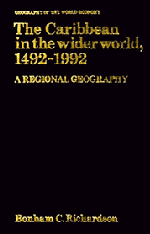Book contents
- Frontmatter
- Contents
- List of maps and tables
- Acknowledgements
- 1 The creation of the Caribbean
- 2 A colonized environment
- 3 Plantations and their peoples to 1900
- 4 The American century
- 5 Economic dependency
- 6 Human migrations
- 7 Resistance and political independence
- 8 Towards a geography of Caribbean nationhood
- Bibliography
- Index
3 - Plantations and their peoples to 1900
Published online by Cambridge University Press: 10 November 2010
- Frontmatter
- Contents
- List of maps and tables
- Acknowledgements
- 1 The creation of the Caribbean
- 2 A colonized environment
- 3 Plantations and their peoples to 1900
- 4 The American century
- 5 Economic dependency
- 6 Human migrations
- 7 Resistance and political independence
- 8 Towards a geography of Caribbean nationhood
- Bibliography
- Index
Summary
The Caribbean plantation is a global, not a regional, enterprise, and it has always been so. The economic historian Richard Sheridan, in describing the British West Indies in the seventeenth and eighteenth centuries, points out that factors of production from throughout the world were united in Caribbean settings, and the unique sum of these introduced parts resulted in the Caribbean plantation: the original domestication site of the principal cash crop (sugar cane) probably was southern Asia; the labor supply and some food crops were of West African origin; building materials, livestock, and food came from eastern North America; and the capital, managerial expertise, and technology were from western and southern Europe (1973: 107).
The warm climates and virgin soils of the Caribbean islands and rimlands underpinned the production of tropical plantation products for the mid-latitude European market. This production was of modest scope under the Spanish in Hispaniola in the early 1500s, but it began in earnest with the English, French, and Dutch colonization of the Lesser Antilles one century later. The trade circulation of plantation products eventually was interlinked with the movement of global inputs for the Caribbean plantation in a complex shipping network often described as the “triangular trade,” involving Europe, West Africa, and Atlantic America from the Guianas to what is now Canada.
- Type
- Chapter
- Information
- The Caribbean in the Wider World, 1492–1992A Regional Geography, pp. 38 - 77Publisher: Cambridge University PressPrint publication year: 1992

